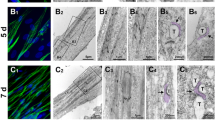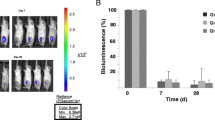Summary
Myogenic cells from mice homozygous for the lethal mutation “motor endplate disease” (med/med) were grown in culture. Like muscle cells taken from wild type (+/?) litter mates they fused to form myotubes which contracted, developed cross striations, and exposed acetylcholine receptors (AChR) on their surface. However, a decrease of 30% in the number of mononucleated cells per unit fresh weight of muscle was observed as early as 2–3 days postnatal, i.e., at least one week prior to the onset of physiological symptoms. Hence, in addition to influencing the functional maintenance of motor endplates, the med gene seems to control early events in muscle development.
Similar content being viewed by others
References
Bekoff A, Betz WJ (1977) Physiological properties of dissociated muscle fibres obtained from innervated and denervated adult rat muscle. J Physiol 271:25–40
Bowden-Essien F (1972) An in vitro study of normal and mutant myogenesis in the mouse. Dev Biol 27:351–364
Burkart W, Jockusch H, Burger MM (1978a) Motor endplate disease: functions exhibited in culture by myotubes from med/med mice. In: Marchbanks R, Lunt G (eds) The Biochemistry of Myasthenia Gravis and Muscular Dystrophy. Academic Press, London New York San Francisco
Burkart W, Jockusch H, Burger MM (1978 b) The developmental potential in culture of muscle cells homozygous for motor endplate disease. Experientia 34:935–936
Duchen LW (1970) Hereditary motor endplate disease in the mouse: light and electronmicroscopic studies. J Neurol Neurosurg Psychiatry 33:238–249
Duchen LW, Stefani E (1971) Electrophysiological studies of neuromuscular transmission in hereditary “motor endplate disease” of the mouse. J Physiol 212:535–543
Duchen LW, Strich SJ (1968) An hereditary motor neuron disease with progressive denervation of muscle in the mouse: the mutant “wobbler”. J Neurol Neurosurg Psychiatry 31:535–542
Greene EC (1935) Anatomy of the rat. American Philosophical Society, Philadelphia. Reprinted (1955, 1959) Hafner Publishing Co, New York
Harris JB, Ward MR (1974) A comparative study of “denervation” in muscles from mice with inherited progressive neuromuscular disorders. Exp Neurol 42:169–180
Hartzell HC, Fambrough DM (1973) Acetylcholine receptor production and incorporation into membranes of developing muscle fibers. Dev Biol 30:153–165
Jockusch H (1977) Neuro-muskuläre Wechselwirkungen. Ansätze zur biochemisch-genetischen Analyse. Naturwissenschaften 64:260–265
Jockusch H, Jockusch BM (1980) Structural organization of the Z-line protein, α-actinin, in developing skeletal muscle cells. Dev Biol 75:231–238
Jockusch H, Burkart W, Burger MM (1976) Research News. Mouse News Lett 55:8–9
Jockusch H, Jockusch BM, Burger MM (1979) Nerve fibers in culture and their interactions with nonneural cells visualized by immunofluorescence. J Cell Biol 80:629–641
Sachs L (1978) Angewandte Statistik. Springer-Verlag, Berlin Heidelberg New York, 5. Aufl
Searle AG (1970) Genetic Appendix. J Neurol Neurosurg Psychiatry 33:249–250
Shainberg A, Burstein M (1976) Decrease of acetylcholine receptor synthesis in muscle cultures by electrical stimulation. Nature 264:368–369
Sidman RL, Green MC, Appel SH (1965) Catalog of the neurological mutants of the mouse. Harvard University Press, Cambridge, Mass
Yaffe D (1973) Rat skeletal muscle cells. In: Kruse JR PF, Patterson Jr MK (eds) Tissue Culture. Methods and Applications. Academic Press, New York
Yasin R, van Beers G, Bulien D, Thompson EJ (1976) A quantitative procedure for the dissociation of adult mammalian muscle into mononucleated cells. Exp Cell Res 102:405–408
Zacks SI, Sheff MF (1977) Regeneration and differentiation of minced anterior tibial muscle explants from mice with MED myopathy. Lab Invest 36:303–309
Author information
Authors and Affiliations
Rights and permissions
About this article
Cite this article
Jockusch, H., Burkart, W. & Burger, M.M. Hereditary motor endplate disease (med) of the mouse: Observations on dissociated myogenic cells and their development in culture. Cell Tissue Res. 207, 241–248 (1980). https://doi.org/10.1007/BF00237809
Accepted:
Issue Date:
DOI: https://doi.org/10.1007/BF00237809




